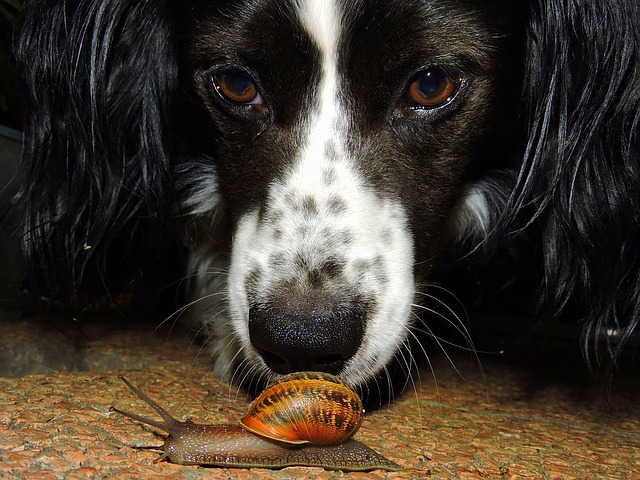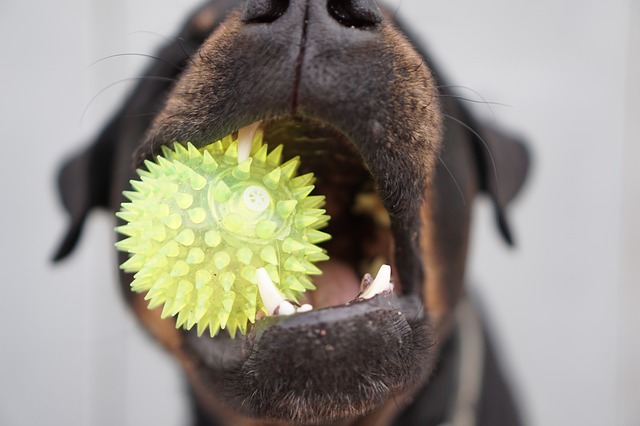We have all heard the horror stories of dogs choking on small items, getting into dangerous medications, or being poisoned by spiteful neighbors.
Empower yourself and protect your pooch from these types of dangers by teaching the “Leave it” and “Drop it” commands that could one day save his life.

Note: Professional dog trainer, Jess Rollins, recommends spending just 15 minutes a day in 5 minute sessions working on these skills to prevent your dog from becoming bored or frustrated.
Teaching the “Leave It” Command
This is your first line of defense when trying to keep your dog away from something that could potentially cause him harm. It is also useful in protecting others from your dog in the case of pups that enjoy chasing bikers, joggers, squirrels, etc.
While there are several steps, don’t feel intimidated. Dogs are highly intelligent and eager to please. Chances are they will catch on quickly and the instructions account for slip-ups and minor setbacks.

Step One:
Place a desirable treat beneath the toe of your shoe where your dog cannot get it. Patiently allow him to sniff, lick and paw at your shoe until he gets bored and gives up.
At the moment the dog quits going after the treat, “mark it” with a word (“Yes” or “Good”) or use a clicker and offer your dog a different treat from your hand – never the treat beneath your shoe. Repeat until your dog has succeeded 5 times.
Next, add your cue. Say “leave it!” firmly when your dog first shows interest in the treat under your shoe. Each time they turn away from the treat, reward them with a treat from your hand. Repeat until your dog has succeeded 5 times.
Step Two:
Put a treat on the floor, but be ready to cover it with your shoe. Tell your dog to “leave it.” If he goes for it, quickly cover it with the toe of your shoe. If he leaves it, reward with a treat from your hand. Repeat.
Step Three:
Drop a treat from a few inches off the floor. Ask your dog to “leave it” as it drops. If he leaves the treat, reward from your hand. If he snatches the treat, go back to step two. Repeat until your dog has succeeded 5 times.
Step Four:
Now it is time to try moving the treat away from you to see if your dog will still follow the “leave it” command. Roll a treat behind you between your legs while telling your dog to leave it. Mark and reward if he is successful. Repeat until your dog has mastered this step.
Step Five:
Try tossing the treats farther, faster and in different directions while giving the “leave it” command and mark/reward your dog’s successes. Repeat until your dog has mastered this step.
Step Six:
Before taking your dog for a walk, head out on the trail by yourself, planting treats or toys along the way. As you walk your dog, give the “leave it” command and reward him with a treat from your hand when he is successful. You may also start out in a less distracting setting, like your own backyard. Repeat until your dog has mastered this step.
Step Seven:
Now it’s time to start practicing the command on regular walks. Try asking your dog to “leave it” when you see objects on the ground that would normally interest your dog and when you see another dog, person, bird, etc. heading your way. Be sure to bring along treats so you can reward your dog for responding to the command.
Step Eight:
If your dog spends time off-leash you will want to practice in a fenced backyard or a quiet, confined area without too many distractions. Try throwing a toy or asking your dog to leave things that commonly distract him like squirrels. The key is to give the “leave it” command as soon as your dog locks in on a target. If you say it too late, the cue may not work.
If your dog fails to respond, calmly leash him and stop all activity for 30 seconds to 1 minute. This teaches that failing to respond to a command will result in a temporary loss of freedom.
Step Nine:
When your dog is ready, practice the “leave it” cue when your dog is off leash at a dog park. Remember to give the “leave it” command as soon as your dog makes a move for something – not when he’s mid-chase. If you have a set-back, simply give a short time-out as above.
Teaching the “Drop It” Command
The “Drop It” command is useful when your dog has already gotten ahold of something before you had a chance to give the “Leave It” cue or when an item is so desirable he ignores the command altogether. Some people also find it helpful during play sessions when the dog is stubborn about releasing the toy or for dogs that resource guard.

Note:
If your dog likes to grab items to entice you into chasing him, you will have to begin by training him that this is no longer an option. Typically, ignoring this attention-seeking behavior is enough to cause a dog to drop it on his own when he gets bored. If he should snag a potentially dangerous object, try distracting him by ringing the doorbell or knocking on the door. The excitement should cause him to drop it.
Step One:
To start, select a few of your dog’s favorite chew toys and some small, but highly tasty treats. Have a treat ready in one hand as you offer your pooch one of the chew toys. As soon as he closes his mouth on the toy, put the treat right up to his nose and give the “drop it” command.
Step Two:
When he releases the toy, praise him and reward him with a treat.
Step Three:
Offer the chew toy to your dog again so you can continue practicing. If your dog does not wish to take the item, don’t force it. You can continue practicing throughout the day by keeping a few treats on hand and asking your pooch to “drop it” whenever you see him pick up a toy or bone. Repeat until your dog has successfully dropped an item on command about 10 times.
Step Four:
Now it’s time to get a bit sneaky! Your dog is now a pro at “drop it” but he expects a treat each time and you may not have one on hand at the time of an emergency. Now you want to teach him to “drop it” no matter what.
Practice the above steps, but only pretend to have a treat in your hand. When he drops the toy or bone, show him your empty hand, then reward him with three treats. Continue practicing until your dog willingly drops the item on the signal of your empty hand every time.
Step Five:
Next, it’s time to increase the difficulty by offering your dog a high value chew treat. It should be something hard like a Dental Stick or Bully Stick that your dog cannot immediately wolf down.
Hold one end of the chew and offer the other end to your dog. Let him put his mouth on it, but don’t let go! Instead, give the “drop it” command and pretend to show him a treat like before. The first time he successfully performs this step, reward your dog with three treats to reinforce the behavior. Practice this step until he drops the chew right away while you hold on to it.
Step Six:
Get another hard chew and several small, but extremely tasty treats like bits of chicken or cheese cubes. This time, when you offer the chew to your dog you will let go of your end and allow him to take it. As soon as he has the chew, say “drop it” while pretending to show a treat.
If he drops the chew, give him 10 treats and the chew to keep! If he doesn’t release the chew, try actually showing him one of the desirable treats. If he still does not drop it, let him keep the chew and try again later with a less desirable chew. You can slowly build up to higher value chews the more you practice.
Step Seven:
*Make sure you have mastered the other steps before attempting this!
Put your training to the test by asking your dog to “drop it” in real life situations with objects he would normally chew such as tissues and shoes. Next, you can try practicing outside with objects like pine cones and sticks.
If you become overwhelmed, consider hiring a professional trainer to help you teach these important commands. Your dog’s safety and your own peace of mind are certainly worth the fee!
H/T to Rover.com & Pet Expertise.com
